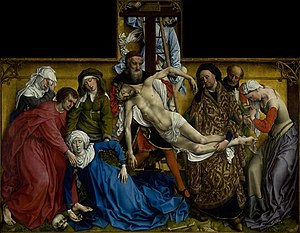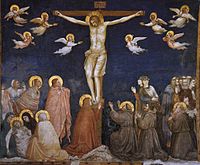Swoon of the Virgin



The Swoon of the Virgin, in Italian Lo Spasimo della Vergine, or Fainting Virgin Mary was an idea developed in the late
The swoon might be placed during the episode of
History
A fainting Mary is sometimes shown in art as early as the 12th century, and becomes common by the middle of the 13th century. For example there is one in the Crucifixion relief on the
However no such incident was mentioned in the
Official disapproval of the swoon gained ground in the
However, no more official condemnation of the belief in the incident came, and although new depictions were fewer, existing ones remained in place, including many in Dominican churches. Indeed, where the swooning Virgin was depicted, she was often even more prominent. Depictions placed other than at the Crucifixion itself avoided many of the theological objections.[8]
The examples illustrated show more complete fainting, but in many images the Virgin remains standing, supported by St John, the
Churches
A number of churches take the name of the Swoon, including:
- Santa Maria dello Spasimo, Palermo, Sicily
- Santa Maria dello Spasimo, Modugno, Bari
- Beata Vergine dello Spasimo, Cerea, Province of Verona
- Madonna dello Spasimo, Bergamo
Gallery
-
Italian, c. 1320
-
Lower Church,Basilica of San Francesco d'Assisi, Assisi
-
Marienkirche, detail from the Berswordt-Altar
-
Boccaccio Boccaccino, Christ Carrying the Cross (National Gallery, London)
-
Christ taking Leave of his Mother, Albrecht Altdorferc. 1520
-
Charles Le Brun, Descent from the Cross
-
Rembrandt, Descent from the Cross, 1632-33 with a literally down to earth depiction (bottom left)
-
In a Christ Carrying the Cross, from a South German church
See also
Notes
References
- ISBN 1-85709-908-7
- ISBN 0-85331-324-5
Further reading
- Neff, Amy, "The Pain of Compassio : Mary's Labor at the Foot of the Cross", 1998, The Art Bulletin, vol. 80, no. 2, pp. 255–273
- von Simson, Otto G., " Compassio and Co-redemption in Roger van der Weyden's Descent from the Cross", 1953, The Art Bulletin, Vol. 35, No. 1, March, 1953, pp. 9–16.
- Rubin, Miri. Mother of God: A History of the Virgin Mary, Allen Lane, 2009, ISBN 0-7139-9818-0








